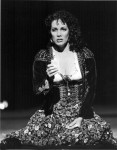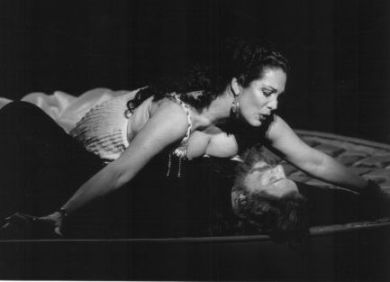Continuing to use Carmen as an example, we now ask what does the music say about your character.
Who is this character in their music?
Now, look at the rhythm of each character and realize that every character has their unique rhythmic tattoo. Even with Carmen, at her very first entrance before she sings the Habanera, there is already the music of her death; it just has a different rhythm! Can you find it?
Jose’s music is lyrical, pleading and romantic, even at the very end when he is pleading for Carmen to come with him. On the other hand, Carmen’s replies are short, terse, and not at all lyrical.
Micaela’s music reflects her strength of character, her connection to the divine. French horns are used so many times in music to reflect majesty and nobility.
For every role you’ll ever do, look at the text in relationship to the character. Let the character reveal itself to you through the music and the rhythm. A composer gives you most of what you need to know right there.
Where does the real you and this character connect?
Now we come to actually putting your stamp on this character. Where is the link that will give you a jumping off place, a place where you can return if things get crazy on stage? After all, it is live theater! The link between you and the character can come from something in the physical appearance or the emotional or mental makeup of the character. Don’t just look for something positive — look at your dark side too. You will often find tremendous excitement and material there for use on the stage.
For example, many years ago when I was just beginning in the business, I was doing a role of a woman in her 50s or 60s and an alcoholic. I didn’t know where to begin: the role was Baba in Menotti’s The Medium. I found my link in the way my mother crooked her index finger when she yelled at me.
One of my students told me she has extraordinary determination in her life and commitment to do what she felt she wanted – it is her perfect connection to Micaela.
What is the back-story of your character?
Now we come to the last, and perhaps the most important, tool for giving your character believability. What is the history of the character before they came to this production? For example, what causes Baba in The Medium to say:
Afraid, am I afraid. Mme. Flora afraid, can it be that I’m afraid? In my young days, I have seen many terrible things, Women screaming as they were murdered, Men’s hands dripping with blood, And little grotesque children, Drained white by the voraciousness of filth.You’d better have a reason for these horrific words or they will never fly. Make up a story as to why your character acts and reacts as they do. Then you will have characters that are flesh and blood and bone. You will have brought to life creatures that will seize your audience’s imagination and will thoroughly entertain you because you are working with a living sculpture, not a mask.
Tools for your toolbox
Use these tools for any character that you create, be it straight theater, opera, voice overs or musical theater. There always needs to be a Who, What, When Where (I add Why?)and How? The more bewitched you are by the character you have created, the more fascinating your character will appear to your audience.
When a character has that kind of depth, it will take many hundreds of performances until finally, you will say: Basta! That’s enough! It took me way over 1500 performances to say goodbye to my l’enfant de Boheme, my Carmen.


